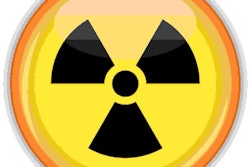
Digital breast tomosynthesis (DBT) exposed women to significantly less radiation than full-field digital mammography (FFDM) in a study of 200 patients published on June 3 in the Journal of Medical Radiation Sciences.
DBT is an increasingly popular breast screening method due to its high cancer detection rate and low number of false-positive rates, as well as lower call-back rates. However, there is some concern over radiation exposure with the modality.
After finding a lack of publications on the topic, researchers from Kuwait conducted their own study to compare the radiation entrance surface dose (ESD) and average glandular dose (AGD) of DBT with that of full-field digital mammography.
"Interestingly, the values of ESD and AGD were lower for DBT than FFDM technique," wrote the authors, led by Dr. Akram Asbeutah, PhD, from the department of radiologic sciences at Kuwait University. "The results of this study are a promising development if DBT is to be considered as a breast cancer screening/detection tool."
The study included 200 female patients referred to the university's breast imaging department after abnormal findings on a clinical breast exam or ultrasound exam. The patients underwent FFDM followed by DBT with a nine-shot step-and-shoot technique.
For both modalities, radiation exposure increased linearly with breast density. But the range of values was significantly lower for DBT than FFDM, the authors found.
| Radiation dose exposure (mGy) for FFDM and DBT | |||||
| Breast thickness | FFDM | DBT | |||
| Highest ESD (mGy) | Total AGD (mGy) | Highest EDD (mGy) | Total AGD (mGy) | ||
| 2.1 - 3.0 cm | 3.3 | 3.3 | 3.1 | 1.8 | |
| 3.1 - 4.0 cm | 4.7 | 4.5 | 4.0 | 2.5 | |
| 4.1 - 5.0 cm | 5.5 | 4.6 | 4.7 | 2.6 | |
| 5.1 - 6.0 cm | 6.7 | 5.0 | 5.9 | 3.0 | |
| 6.1 - 7.0 cm | 8.1 | 5.6 | 7.8 | 3.6 | |
| 7.1 - 8.0 cm | 9.1 | 6.0 | 8.9 | 4.0 | |
The authors hypothesized that entrance surface dose and average glandular dose were lower with DBT than FFDM because the latter takes two views of the breast, whereas DBT only takes one. DBT's single view provides the benefit not only of a lower radiation dose but also of reduced patient discomfort because it uses fewer breast compressions, the authors noted.
DBT may also have produced lower radiation doses than FFDM because the authors used an antiscatter grid during their step-and-shoot technique, which absorbs a part of the primary radiation. They also used an Rh/Rh target filter with high tube voltages and low tube loads for DBT.
It is also important to note that the authors found a significant difference in average glandular dose values reported on the mammography machine and the ones calculated by the authors, a finding noted in other studies. This could be the result of breast density or a difference between the manufacturer-specified guidelines for optimal image quality and the actual, clinical implementation. Future studies with different mammography units will be needed to confirm their results.
"The total AGD for single-view DBT was lower than a two-view FFDM for single breast imaging," the authors concluded. "This offers opportunities for the implementation of DBT in the breast cancer detection with consideration of clinical outcome and quality of diagnosis."



















